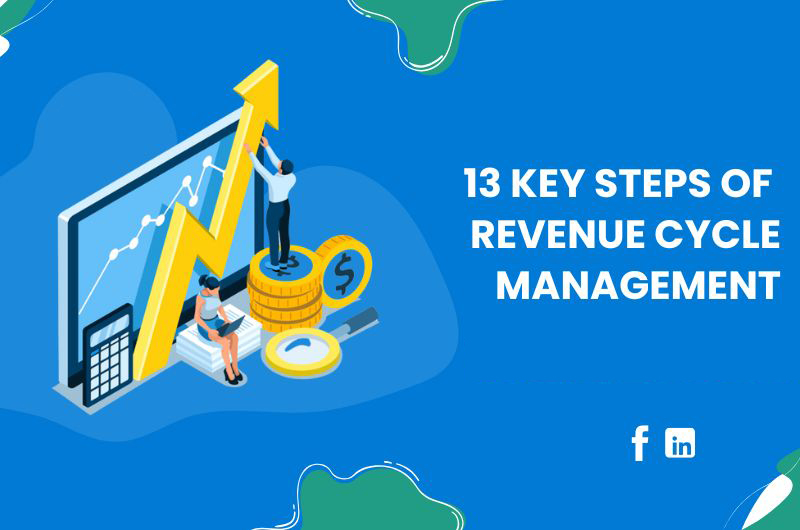Revenue cycle management is like a step-by-step process that helps healthcare providers handle their payments smoothly. But mistakes happen.
Did you know over 80% of medical bills have errors? These errors can slow down payments, sometimes for weeks or even months!
Today, here in this blog guide, we are breaking down the 13 important steps of RCM into easy-to-understand parts.
Think of it as a chain where every link is connected—if one breaks, it can cause delays. By learning these steps, you will see how to avoid mistakes, fix problems quickly, and make sure payments arrive on time.
Let’s dive into it and learn how it works!
What is Revenue Cycle Management (RCM)?
Before knowing the 13 steps of Revenue Cycle Management (RCM), it is essential to understand what exactly is RCM. Well, on a simple note, it’s the financial process healthcare providers use to manage revenue—from a patient’s first appointment to their final payment. It is a vital part of keeping healthcare businesses thriving and financially stable.

Why does RCM matter?
Effective RCM helps reduce billing errors, speeds up payments, and improves patient satisfaction. For independent healthcare providers, however, RCM can feel overwhelming due to its complexity. Yet, in an industry where every dollar counts, understanding and managing RCM is crucial.
RCM covers every stage of a patient’s journey, from scheduling appointments to processing claims and collecting payments. It involves submitting accurate medical bills, coding procedures, and ensuring all payments are collected. For the AI Medical Scribe for Healthcare Provider, visit the AI Medical Scribe.
13 Key Steps of Revenue Cycle Management
Did you know that nearly 65% of healthcare providers face claim denials due to errors in billing and coding? Effective Revenue Cycle Management (RCM) is crucial for minimizing these losses and ensuring smooth financial operations.
Step 1: Pre-Registration
The revenue cycle kicks off with pre-registration, even before patients arrive at the facility. This step involves collecting and verifying patient details, including eligibility and insurance information. Missing or incorrect information at this stage can result in costly claim denials and dissatisfied patients later.
Best Practices:
- Use technology that facilitates real-time benefit verification with insurers.
- Provide user-friendly online portals for patients to input their data.
- Offer multiple pre-registration options, such as online, over the phone, or in person.
Step 2: Registration
A seamless registration process enhances the patient experience and ensures accurate data collection. During registration, patient details are reviewed and updated, and the check-in process is completed.
Best Practices:
- Ensure accurate entry of patient demographics and insurance details.
- Train staff on the importance of thorough data collection.
- Conduct regular audits to minimize errors during registration.
Step 3: Charge Capture
Accurate charge capture ensures that all patient services are properly documented and billed. This step includes recording and coding all treatments, procedures, and supplies used during patient care.
Best Practices:
- Leverage technology for real-time charge entry.
- Schedule regular audits to identify missed charges.
- Cross-check coding processes to avoid overlooked billable items.
Step 4: Claims Submission
Timely and accurate submission of claims is critical for maintaining cash flow. After charges are recorded, claims must be prepared and sent to payers for reimbursement.
Best Practices:
- Monitor claims for errors or rejections regularly.
- Use automated systems to streamline the claims process.
- Collaborate with electronic claims clearinghouses to reduce submission delays.
Step 5: Proper Coding
Accurate coding is vital for precise billing and maximizing reimbursement. Certified coders assign standardized codes to diagnoses, procedures, and services provided to patients.
Best Practices:
- Audit coding practices to detect and fix errors.
- Provide ongoing training for staff on coding updates.
- Employ certified medical coders for enhanced accuracy.
Step 6: Patient Billing
Once payers process claims, the remaining balance, including co-pays, deductibles, or uncovered services, is billed to patients. Errors in patient billing can lead to dissatisfaction, delayed payments, and damage to the provider-patient relationship.
Best Practices:
- Offer multiple payment methods for convenience.
- Maintain transparency in billing practices to build trust.
- Send bills promptly to minimize payment delays.
Step 7: Payment Processing
Effective payment processing ensures revenue is collected quickly and accurately. This step involves posting payments received from payers and patients and addressing any discrepancies.
Best Practices
- Implement robust payment systems to minimize errors.
- Provide online payment options for patient convenience.
- Reconcile payments diligently to avoid discrepancies.
Step 8: Insurance Follow-Up
Regular follow-ups with insurance companies are essential for resolving denied or underpaid claims. This process includes identifying denial causes, submitting supporting documents, and re-submitting claims when necessary.
Best Practices:
- Actively follow up on unpaid claims to ensure timely resolution.
- Build strong relationships with insurance providers to expedite processes.
- Use claim-tracking software to monitor delays or denials.
Step 9: Denial Management
Managing denials effectively is crucial to minimizing revenue loss. This step focuses on analyzing denial trends, addressing root causes, and implementing strategies to prevent future occurrences.
Best Practices:
- Identify common reasons for denials and take corrective action.
- Train staff on effective denial management techniques.
- Track denial patterns to optimize processes.
Step 10: Appeals
For improperly denied claims, the appeals process involves gathering documentation, adhering to payer-specific guidelines, and submitting appeals within deadlines.
Best Practices:
- Document all communication related to appeals thoroughly.
- Use data and evidence to support the appeal for better outcomes.
- Stay organized and escalate issues when necessary.
Step 11: Patient Collections
Recovering outstanding balances requires clear communication and patient-friendly strategies. This step involves offering flexible payment options and addressing delinquent accounts appropriately.
Best Practices:
- Use patient-centered approaches for payment reminders.
- Offer payment plans tailored to patients’ financial circumstances.
- Establish clear, transparent payment policies.
Step 12: Reporting and Analysis
Comprehensive reporting and analytics are essential for identifying inefficiencies and making informed decisions within the revenue cycle.
Best Practices:
- Monitor key performance indicators (KPIs) like denial rates and days in accounts receivable.
- Share regular reports with stakeholders for accountability.
- Use data analytics to pinpoint improvement areas and increase efficiency.
Step 13: Compliance
Adherence to regulations for coding, billing, and privacy is non-negotiable. Even minor lapses can result in significant penalties and damage to the organization’s reputation.
Best Practices:
- Invest in dedicated compliance teams or seek external expertise.
- Conduct regular audits and risk assessments.
- Train staff to stay updated on regulatory requirements.
The Conclusion
Steps of Revenue Cycle Management (RCM) is like a roadmap that helps healthcare facilities handle patient services and payments smoothly. By following the 13 above-mentioned steps, hospitals and clinics can ensure they provide excellent care while keeping their finances in check.
Each step, like accurate billing, timely payments, and good communication, works together to avoid errors, speed up payments, and keep patients happy.
By using modern technology and training staff well, healthcare providers can make their RCM processes even better. This not only reduces mistakes but also saves time and money.
In 2025, staying organized and following these steps will be more important than ever to ensure everything runs smoothly.
So, whether it is checking insurance details, coding correctly, or managing denied claims, each step plays a big role in making healthcare work better for everyone!
Ready to optimize your 13 Key Steps of Revenue Cycle Management (RCM)? Keizer Technologies is offering medical billing and coding services all across the USA.


